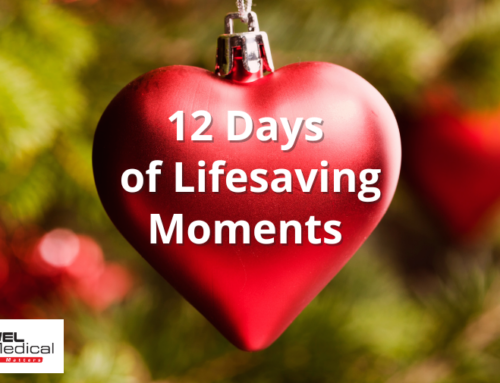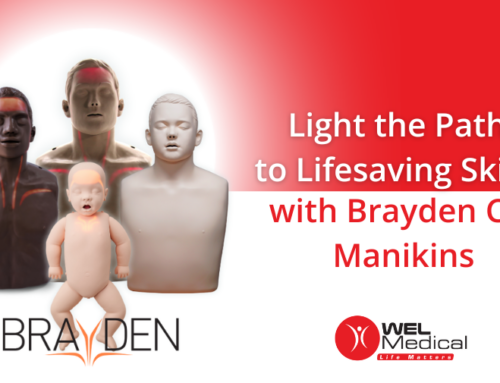[vc_row][vc_column][vc_column_text]“Where could I put a defibrillator?” It’s a question we get asked almost more than any other.
In truth, the answer is: where couldn’t you put one? Defibrillators are so highly portable, so easy to store, and so crucial when it comes to the chain of survival, there simply aren’t many places that couldn’t benefit from having one.
The stats behind that need speak for themselves:
- There are more than 30,000 out-of-hospital cardiac arrests (OHCAs) in the UK each year, but the survival rate is just one in ten. That’s 27,000 people who might be alive had they been given the proper treatment in the right timeframe.
- During an OHCA, every minute that passes without CPR and defibrillation is 10% of a person’s survival chances gone. At ten minutes, it’s essentially all over.
Together, these numbers make clear the need for widespread CPR training and considerably more defibrillators in high-footfall public spaces.
All of that said, we know many businesses and organisations might understand that need in principle, but still be held back by the logistical issue of where to store a defibrillator. If your enterprise is among them, then read on for our suggestions of ten surprising places that need defibrillators.
Public-facing service vehicles
The more defibrillators are out there in public spaces, the more lives are likely to be saved. However, even if the numbers increased a hundred-fold, there would still be the issue of how readily accessible units actually are.
One potential solution is to make them mobile – by placing them on buses, trains, in taxis, and even in the vehicles of roaming services like The AA and RAC. Add an app with geolocation that lets you see where your nearest mobile defibrillator is, and this could be a game-changer when it comes to saving lives.
Stadium concourses
The recent Christian Eriksen incident at Euro 2020 highlights the need for sports teams to have a defibrillator handy for players. But what about for fans? In truth, many stadiums might have a St John’s ambulance team on sight during the build-up to a game, and their defibrillator is likely to be in the ambulance outside the ground. However, stadiums are simply so large that if a cardiac arrest occurs to someone getting their halftime pie and Bovril, the chances of that defibrillator making it to them within the ten minutes needed to save them are reasonably low.
Placing at least one defibrillator inside the concourse on every side of the ground could be the difference between that fan getting to watch their favourite player again or not. It’s definitely one of those places you wouldn’t think needs a defib until you consider it. Then it becomes a question of – why aren’t they there as standard?[/vc_column_text][vc_empty_space][vc_column_text]
National Heritage sites
[/vc_column_text][vc_empty_space height=”16px”][vc_single_image image=”2373″ img_size=”full”][vc_empty_space height=”16px”][vc_column_text]National trust sites like castles, manors, priories and chapels, attracted more than 6.4 million people in 2019-20, with over 28% of surveyed adults saying they visit one or more at least three times a year. That’s an awful lot of people in one place, any of whom could experience an unexpected cardiac arrest. Placing a defibrillator in just one or two locations – ideally somewhere central, like a protected box in a castle courtyard, or the reception area of a stately home – would help reassure members and visitors alike that their health and safety is of the utmost concern.
High streets
A high street is another of those public places you wouldn’t think needs a defib, but definitely does. That’s because it’s simply not common to walk down a high street and see the defibrillator logo. But when you stop to think about it, it really should be.
As the global pandemic recedes and high streets surge back to life, so too is there a surge in the chances of a sudden cardiac arrest amongst the hordes of shoppers.
With dozens of shops in these locations, all it would take is for each business to put in £50. With the accumulated funds, they could purchase a defibrillator that could sit neatly in a weatherproof case attached to a shopfront in a central location. Or double those donations, and they could afford to buy and store one at each end of the high street.
Golf Clubs
There are around 500 cardiac arrests in UK golf clubs each year. The survival rate in these instances is less than 2%. That’s a (excuse the pun) shocking number that falls well below the national average.
The reason is obvious. Those golf clubs that do have a defib tend to keep it in the clubhouse. Golf courses, however, are extremely large. By the time word has got back and a defib has made it to where it’s needed, it’s often too late.
We’ve worked with many golf clubs and we always give the same advice: the most suitable location for a defibrillator is with your greenkeeper; especially if they are instantly contactable. After all, they’re the one person likely to be in the best place to rush such life-saving equipment to where it’s needed most, as quickly as possible.
Neighbourhood Watch schemes
Another of the places you wouldn’t think needs a defib is… your house! Or your neighbours’ house. Or indeed, any area that takes active pride in looking after its people and services.
Of course, it’s worth considering that such schemes often have a limited amount of money, and upkeep for things like local parks and other public facilities is certainly not cheap. At the same time, however, it’s really no use shutting the gate after the horse has bolted. You may invest in a defibrillator and not use it – but if and when it is needed, it’s absolutely crucial that it’s there. That’s why we’d recommend one house in every large neighbourhood affixing a defib box to their outside wall. It’s simply the ultimate investment in the health and safety of you and your neighbours.
Park Run and similar pop-up sporting events
While fixed-location sports centres and gyms might be an obvious place for a defibrillator, one place you might not expect to find a defibrillator is a park or cross-country event. However, when you consider how hard people often push themselves at these things, it just makes sense to have one there – just in case.
In terms of a specific suitable location for a defibrillator at one of these events, you can’t go wrong by having it on-hand in a vehicle. That way, if word comes that someone has collapsed, one of your team can jump behind the wheel and get to them quickly.
Meeting houses, shelters and lodges
Another of the surprising places that need defibrillators are locations that house small to medium-sized gatherings. Quaker houses for instance are known to accommodate support groups of all kinds. There are also Masonic Lodges (whose members are typically more prone to cardiac arrest due to age), YMCA houses and even restaurant and hotel function rooms. The sheer regular footfall in these locations marks them out as a perfect (if surprising) place to house a defibrillator.[/vc_column_text][vc_empty_space height=”16px”][vc_row_inner][vc_column_inner][vc_column_text]
Shopping centres and outdoor markets
[/vc_column_text][/vc_column_inner][/vc_row_inner][vc_empty_space height=”16px”][vc_single_image image=”2374″ img_size=”full”][vc_empty_space height=”16px”][/vc_column][/vc_row][vc_row][vc_column][vc_column_text]Our penultimate place you wouldn’t think needs a defib is anywhere that plenty of people go to shop! Malls might be an obvious candidate here, but any place people regularly attend to part with their hard-earned money might be an excellent candidate for a defibrillator.
Having said that, some of these places might pose more of a challenge than others when it comes to housing a unit. A shopping mall has plenty of places where you could affix a storage container, but pop-up jumble sales and markets could be more transient in nature. In the case of the latter, the organisers may want to keep a defibrillator at their own stall. Or, if it’s a council-sanctioned market, they may wish to place one outside the nearest council-owned facility, be it on the wall of a council building or by the entrance to a public loo.
Business and leisure parks
From spending money to making it, our final surprising places that need a defibrillator is business parks – particularly ones with lots of small-medium sized businesses, or a few big corporations with a large number of employees.
Again, accessibility is key here, so the most suitable spot for a defibrillator in such a location is the business right in the middle. Or if the park is especially large, two at each end, and one in the middle
If each business present contributes to the cost, buying a defib should really be no problem. The message it sends to employees meanwhile is worth a whole lot more – and even more still should the unit end up being used.
Do you need a defibrillator?
At WEL Medical, we think of a defibrillator similar to how we see a fire extinguisher. No business or public enterprise would be without the latter, so it’s often startling to think how we as a society invest in protecting our property more than our people.
Our experience tells us that whatever kind of space you have or organisation you’re involved in, a defibrillator could genuinely be one of the best investments you’ve ever made. Storing one is rarely a problem, and when people club together, affording one is rarely a real roadblock either.
Which just leaves two questions to ask: where will you put your defibrillator, and how will you let people know it’s there if they need to use it?
To get yours, check out our full range here. Not sure which is right for you? Get in touch with us to talk through your options.
Related articles
For more information on defibrillators, see the following posts:
- What Happens When You Use A Defibrillator?
- Soccer Shock: Why Football Needs Defibrillators at Every Level
[/vc_column_text][/vc_column][/vc_row]





